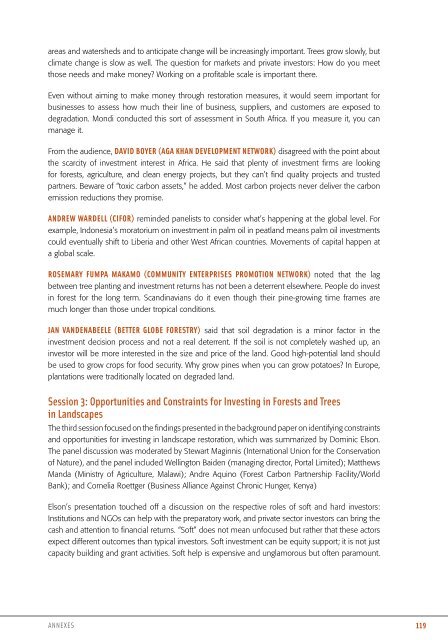INVESTING IN TREES AND LANDSCAPE ... - PROFOR
INVESTING IN TREES AND LANDSCAPE ... - PROFOR
INVESTING IN TREES AND LANDSCAPE ... - PROFOR
You also want an ePaper? Increase the reach of your titles
YUMPU automatically turns print PDFs into web optimized ePapers that Google loves.
areas and watersheds and to anticipate change will be increasingly important. Trees grow slowly, but<br />
climate change is slow as well. The question for markets and private investors: How do you meet<br />
those needs and make money? Working on a profitable scale is important there.<br />
Even without aiming to make money through restoration measures, it would seem important for<br />
businesses to assess how much their line of business, suppliers, and customers are exposed to<br />
degradation. Mondi conducted this sort of assessment in South Africa. If you measure it, you can<br />
manage it.<br />
From the audience, DAVID BOYER (AGA KHAN DEVELOPMENT NETWORK) disagreed with the point about<br />
the scarcity of investment interest in Africa. He said that plenty of investment firms are looking<br />
for forests, agriculture, and clean energy projects, but they can’t find quality projects and trusted<br />
partners. Beware of “toxic carbon assets,” he added. Most carbon projects never deliver the carbon<br />
emission reductions they promise.<br />
<strong>AND</strong>REW WARDELL (CIFOR) reminded panelists to consider what’s happening at the global level. For<br />
example, Indonesia’s moratorium on investment in palm oil in peatland means palm oil investments<br />
could eventually shift to Liberia and other West African countries. Movements of capital happen at<br />
a global scale.<br />
ROSEMARY FUMPA MAKAMO (COMMUNITY ENTERPRISES PROMOTION NETWORK) noted that the lag<br />
between tree planting and investment returns has not been a deterrent elsewhere. People do invest<br />
in forest for the long term. Scandinavians do it even though their pine-growing time frames are<br />
much longer than those under tropical conditions.<br />
JAN V<strong>AND</strong>ENABEELE (BETTER GLOBE FORESTRY) said that soil degradation is a minor factor in the<br />
investment decision process and not a real deterrent. If the soil is not completely washed up, an<br />
investor will be more interested in the size and price of the land. Good high-potential land should<br />
be used to grow crops for food security. Why grow pines when you can grow potatoes? In Europe,<br />
plantations were traditionally located on degraded land.<br />
Session 3: Opportunities and Constraints for Investing in Forests and Trees<br />
in Landscapes<br />
The third session focused on the findings presented in the background paper on identifying constraints<br />
and opportunities for investing in landscape restoration, which was summarized by Dominic Elson.<br />
The panel discussion was moderated by Stewart Maginnis (International Union for the Conservation<br />
of Nature), and the panel included Wellington Baiden (managing director, Portal Limited); Matthews<br />
Manda (Ministry of Agriculture, Malawi); Andre Aquino (Forest Carbon Partnership Facility/World<br />
Bank); and Cornelia Roettger (Business Alliance Against Chronic Hunger, Kenya)<br />
Elson’s presentation touched off a discussion on the respective roles of soft and hard investors:<br />
Institutions and NGOs can help with the preparatory work, and private sector investors can bring the<br />
cash and attention to financial returns. “Soft” does not mean unfocused but rather that these actors<br />
expect different outcomes than typical investors. Soft investment can be equity support; it is not just<br />
capacity building and grant activities. Soft help is expensive and unglamorous but often paramount.<br />
ANNEXES<br />
119

















